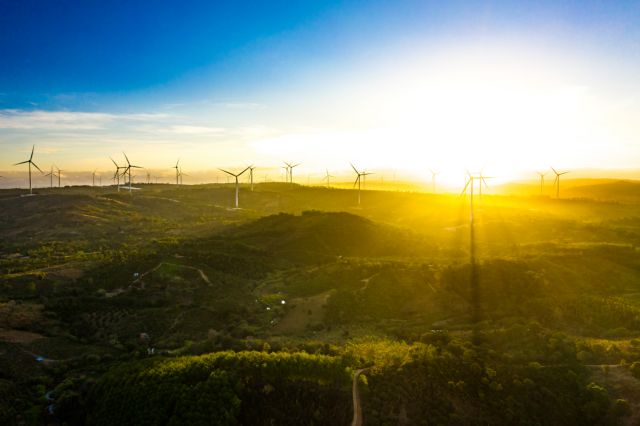The potential of renewable energy sources, especially wind and solar power, is one of the keys to Viet Nam's energy transformation towards carbon neutrality, but the unresponsive transmission network is wasting the capacity of billions of kWh of electricity.

The potential of renewable energy sources, especially wind and solar power, is one of the keys to Viet Nam's energy transformation towards carbon neutrality, but barriers stemming from the unresponsive transmission network and pricing mechanism is wasting the capacity of billions of kWh of electricity, according to experts.
According to preliminary surveys and assessments, Viet Nam's potential of onshore wind power is about 217GW, and offshore wind power is over 160GW. The feature of offshore wind power is long operating hours and high efficiency.
Le Thanh Thanh, deputy director of Soc Trang Department of Industry and Trade, said: "The province has planned to develop 20 wind farms including 18 farms being granted investment certificates with a total capacity of 1,345MW and two farms being considered.
Among 18 farms, 11 projects started construction in 2020 with a total capacity of 496.4MW. As of October 31, 2021, the last day of FIT price, four farms were put into commercial use, he said, adding other projects were also completed but could not be connected to the grid because the FIT pricing mechanism had expired.
Thanh told local media: "The province still has many locations that could develop farms. However, they have to wait for the PDP VIII (The National Power Development Plan for the 2021-30 period, with a vision towards 2045) to be approved to have a basis for proposing a new project."
In the southernmost province of Ca Mau, the People's Committee chairman Huynh Quoc Viet said: "Ca Mau has 16 wind farms with a capacity of 1,000MW. In which, 12 projects have been granted investment certificates, and five investors have implemented their projects, but only three have been connected to the national grid to run commercial operation with a total capacity of only 100MW as of the FIT deadline."
Viet said: "As a locality with great potential for wind power development, the province has proposed to add 24 wind power projects with a capacity of 12,018MW to the national power development plan. However, it still needs to wait for the PDP VIII to be approved."
According to the Vietnam Electricity (EVN), by the end of October 31, 2021, the final deadline for recognition of commercial operation projects and for the projects to enjoy the support price (FIT) under Decision No. 39/QD-TTg of the Prime Minister, 84/146 wind power projects had signed power purchase agreements (PPAs) with EVN, with a total capacity of nearly 4,000MW.
Thus, 62 projects with a total capacity of 4,170MW which also had PPA contracts with EVN, but due to slow progress, could not be put into commercial operation on time. Many projects have completed construction and equipment installation but could not be operated commercially due to the end of the FIT pricing mechanism, said EVN.
International energy organisations calculated the potential of solar power in the country at 434GW, including terrestrial solar power with 309GW, offshore solar power with 77GW and rooftop solar power with 48GW.
As of the Government's incentive mechanism, more than 16,400MW of solar power sources have been put into operation, including 7,755MW of rooftop solar power sources since 2019, most of them concentrated in the southern and central regions.
While Viet Nam is trying to develop solar power, the projects' development pace is faster than that of transmission infrastructure.
As a result, the power industry has temporarily suspended the connection of new projects and reduced the capacity of both projects.
According to EVN, in 2021, the untapped electricity output of the aforementioned renewable energy sources, which has increased to 1.68 billion kWh including 1.25 billion kWh of solar power, had to be reduced by 430 million kWh as per the EVN programme.
Experts consider the increasing untapped output of renewable energy sources as "a huge waste" while other thermal power sources are in short supply, and the electricity price is increasing. — VNS





